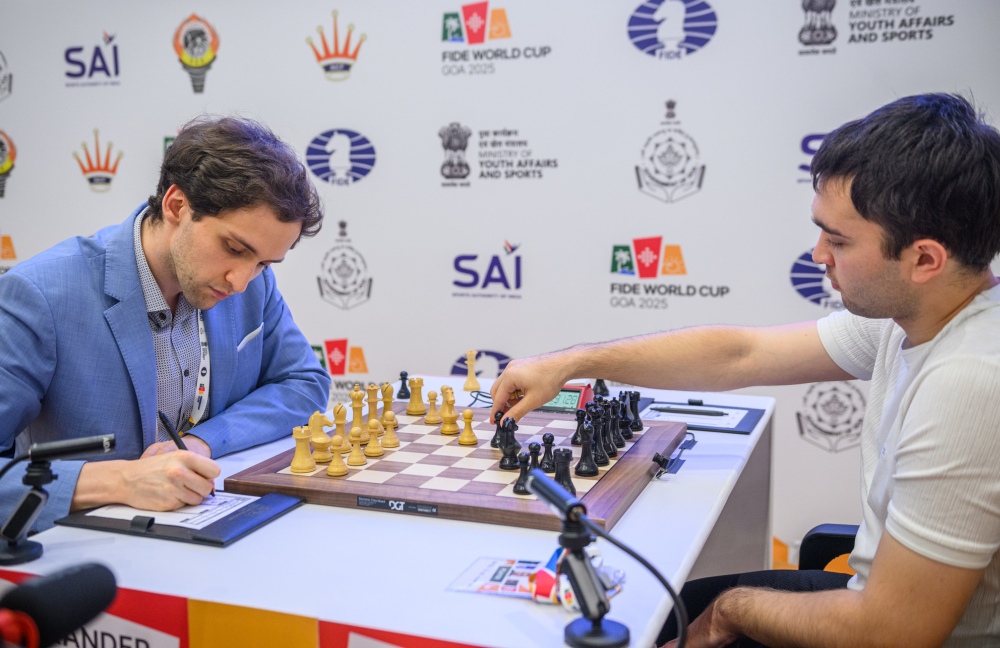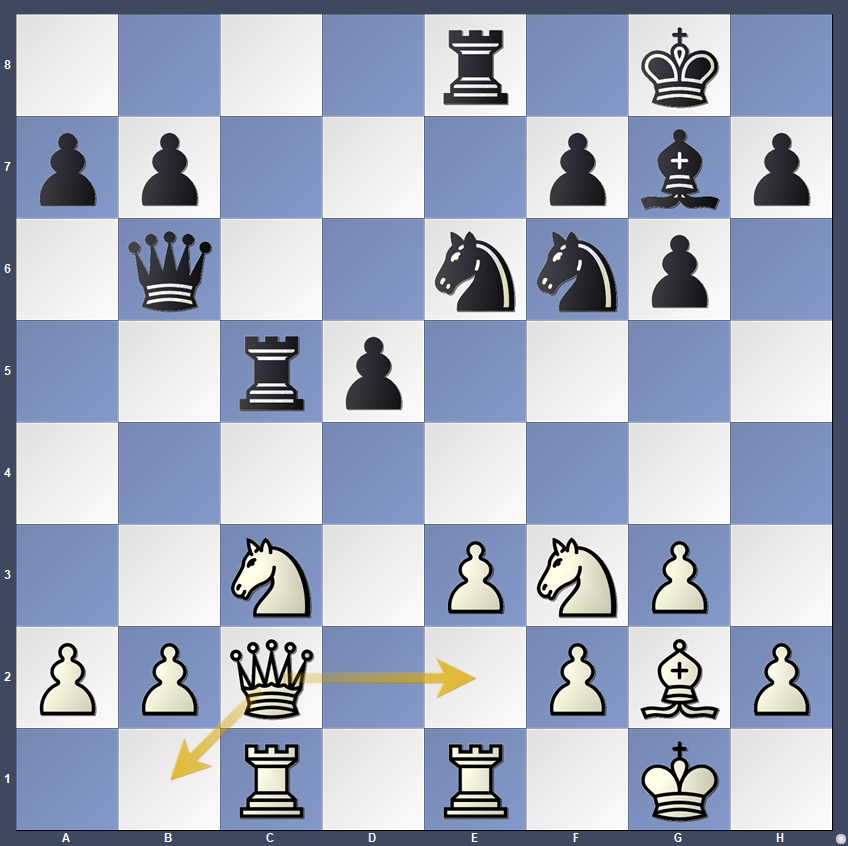
The tension was evident as players entered into the playing hall today, several arriving just minutes before the clocks were started, a sure sign of the pressure mounting at this decisive stage of the World Cup. The air in the playing hall was quiet and concentrated, yet packed with spectators eager to witness the eight remaining players in action. With only four spots in the semifinals, chess fans were treated to a blend of high-stakes precision and tightly controlled risk. The outcome was draws across all boards, meaning tiebreaks in three of them, and GM Nodirbek Yakkuboev advancing as the first semi-finalist after his victory over Alexander Donchenko yesterday.
Before play began, the ceremonial first move was made by Mr. Anurag Singh Thakur, former Sports Minister of India, Member of Parliament, and Chairman of the Parliamentary Standing Committee on Coal and Mines on Board 2, for Erigaisi vs. Wei Yi.

Quarterfinals Game 2 results:
- José Eduardo Martínez Alcántara ½-½ Javokhir Sindarov
- Arjun Erigaisi ½-½ Wei Yi
- Andrey Esipenko ½-½ Sam Shankland
- Alexander Donchenko ½-½ Nodirbek Yakubboev
With the semifinal lineup still very much undecided, here’s a closer look at how each game unfolded today.
Nodirbek Yakkuboev (2689) vs Alexander Donchenko (2641)

Alexander Donchenko had a great deal at stake today. After fighting hard to survive the Round 5 tiebreaks, his classical loss yesterday left him in a must-win situation. He certainly tried, pushing until the very end, creating an imbalanced structure that forced Yakubboev to stay alert.
The game followed the Exchange Variation of the Queen’s Gambit Declined, and Donchenko appeared well-prepared, gaining a 30-minute time advantage early on. However, despite his confident opening, his pace slowed and a series of imprecise choices led to a position where his winning chances faded.
Black has just played the thematic 21…Bb1, aiming for a Ba2–c4 maneuver. While White has no obvious plan here, Donchenko chose one of the weakest options with 22.f3?, a move our commentators called “strange” as it gave Black easy counterplay. Yakkuboev responded with 22…f5 and followed through with his intended bishop maneuver, fully seizing the initiative. The critical moment came soon:
White’s pieces were poorly coordinated, and the pawns on the third rank were vulnerable. Here, the powerful 26…Re8 could have posed major problems for White, especially with the threat of …Nb5 looming. If White tries passive defense with 27.Re1 Black builds up pressure with 27…Rb5 28.Rc2 Rb3. For instance, the natural-looking 29.Ng2 to guard the e-pawn is met by 29…Bd3 30.Rf2 (or 30.Rc3, also losing) 30…Bxb1 31.Rxb1 Nc4, leaving Black in full control.
Instead, Yakkuboev started with 26…Rb5, allowing 27.Rg2. Though Donchenko escaped immediate danger, Black still held a comfortable edge. After further exchanges, the game entered a tense endgame where White appeared to retain some chances. However, Yakkuboev maintained accuracy and steered the game to a dead-even draw. With this result, he became the first player to qualify for the semifinals of the 2025 World Cup.
Wei Yi (2752) vs Arjun Erigaisi (2773)
As the only remaining Indian player in the field, Grandmaster Arjun Erigaisi carries significant expectations. Yet he has remained composed throughout the event, arriving calm at the board each day and greeting enthusiastic fans waiting (and chanting his name) outside.

After a quick draw yesterday, today’s strategy was different – with the White pieces, Arjun prepared a fresh idea in the Queen’s Gambit Declined. Wei Yi, however, played confidently and quickly as well. The game soon left known theory and entered territory in which both players could just play chess.
Tension started when Wei Yi chose to complicate with 18…c5, accepting an isolated queen’s pawn but gaining activity. The position suddenly became sharp:
Arjun played the quiet-looking 20.Qe2 instead of the more natural 20.Qb1. Commentators GMs Jan Gustafsson and Peter Leko praised it as “strong and unexpected,” as it unpins the queen while provocatively placing it opposite Black’s rook and hinting at Na4 ideas. It posed psychological pressure. Wei Yi spent over 30 minutes here, visibly unsettled and shifting in his chair, before deciding on 20…Qc6. After 21.Nd2, however, Black 21…Nd7? (21…Nh5 was the better choice – we will get into that mess later, so bear with me if you want to get into deep analysis) allowing a tactical sequence: 22.Nb3 Bxc3 23.bxc3 Rxc3
Here Arjun had a golden opportunity – 24.Bxd5! and after 24…Qc8 25.Rxc3 Qxc3 White simply captures a free pawn with 26.Bxb7. Black also can choose 24…Qxd5 – and here is why the earlier mistake of 21…Nd7 matters. 25.Rxc3 Ng5 26.e4 (only move to keep the advantage and stop …Nf3), 26…Rxe4 27.Rd1! And the d7-knight is ill-placed and hanging.
Instead, Erigaisi played 24.Qd2? and after 24…Rxc1 25.Rxc1 Qa6 26.Bxd5 Nf6! Wei Yi equalized and the game was drawn on move 32.
Now let’s go back to the better 21…Nh5 which makes the difference. Now 22.Nb3 Bxc3 23.bxc3 Rxc3 24.Bxd5 does not hold the same venom after 24…Qxd5 25.Rxc3 Ng5 26.e4 Rxe4 and Black’s pieces, particularly the knights, are very active. The same idea we saw in the previous line of 27.Rd1 is a big blunder because of the desperado 27…Qxb3! And suddenly Black would be winning. This tactic would not be the same with the knight on d7.
All of this analysis just goes to show how small nuances of a position can affect the evaluation but only surface moves later, and it’s curious to know whether all of this was seen. After intense days like these, we don’t corner the players for interviews, but after tomorrow I will definitely find out from the match’s victor how much was calculated here.
Javokhir Sindarov (2721) vs José Eduardo Martínez Alcántara (2644)
The draw between Sindarov and Martínez was the most curious result of the day, not for the score, but for how swiftly it was achieved. The players entered a known drawing line in the Four Knights Spanish and followed the theory to a peaceful result in just 20 minutes.

For Martínez, who had the White pieces and momentum from previous rounds, it was an unexpectedly conservative approach. But strategic choices like this can be understood – conserving energy, maintaining focus, and preparing for potential tiebreaks are all part of the long World Cup journey.
Sam Shankland (2654) vs Andrey Esipenko (2693)
This matchup was intriguing from the outset, due to Shankland’s opening choice with Black: 1.e4 e5 2.Nf3 Nc6 3.Bc4 d6 a clever move order that sidestepped Esipenko’s preparation and secured a solid foundation.
Esipenko appeared frustrated by his inability to pose challenges. Though his pieces were well-coordinated, no breakthrough was in sight. The evaluation bar stayed balanced, and after a series of logical exchanges, the players agreed to a draw on move 32.

Both players have strong tiebreak credentials; Esipenko defeated pre-tournament favorite Vincent Keymer in Round 4, while Shankland eliminated Vidit Gujrathi, Richard Rapport, and most recently Daniil Dubov. If this match heads to rapid and blitz, it promises to be one of the most competitive encounters of the round.
With all four games ending in draws today, the tension only rises as we head into the tiebreaks. Three semifinal spots are still up for grabs, and with these players evenly matched and deeply battle-tested, the next phase promises to be intense. Expect a day of exciting chess and tight nerves as everything comes down to the faster formats. One thing is certain: tomorrow will deliver high drama over the board.
Quarterfinal tiebreaks will be played on November 19, starting at 3 PM local time.
The action can be followed live on the FIDE YouTube Channel, featuring expert commentary by GMs Jan Gustafsson and Peter Leko.
To watch the games in person, tickets can be purchased [HERE]
Written by WIM Charlize van Zyl (Goa, India)
Photos: Michal Walusza






